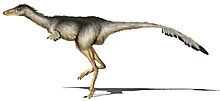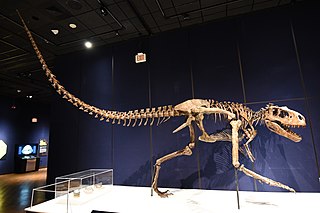
Albertosaurus is a genus of large tyrannosaurid theropod dinosaur that lived in northwestern North America during the early to middle Maastrichtian age of the Late Cretaceous period, about 71 million years ago. The type species, A. sarcophagus, was apparently restricted in range to the modern-day Canadian province of Alberta, after which the genus is named, although an indeterminate species has been discovered in the Corral de Enmedio and Packard Formations of Mexico. Scientists disagree on the content of the genus and some recognize Gorgosaurus libratus as a second species.
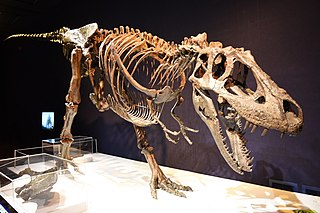
Daspletosaurus is a genus of tyrannosaurid dinosaur that lived in Laramidia between about 78 and 74.4 million years ago, during the Late Cretaceous Period. The genus Daspletosaurus contains three named species. Fossils of the earlier type species, D. torosus, have been found in Alberta, while fossils of a later species, D. horneri, have been found only in Montana. D. wilsoni has been suggested as an intermediate species between D. torosus and D. horneri that evolved through anagenesis, but this theory has been disputed by other researchers.

Shuvuuia is a genus of bird-like theropod dinosaur from the late Cretaceous period of Mongolia. It is a member of the family Alvarezsauridae, small coelurosaurian dinosaurs which are characterized by short but powerful forelimbs specialized for digging. The type species is Shuvuuia deserti, or "desert bird". The name Shuvuuia is derived from the Mongolian word shuvuu (шувуу) meaning "bird".

Parvicursor is a genus of tiny maniraptoran dinosaur with long slender legs for fast running.

Alvarezsauridae is a family of small, long-legged dinosaurs. Although originally thought to represent the earliest known flightless birds, they are now thought to be an early diverging branch of maniraptoran theropods. Alvarezsaurids were highly specialized. They had tiny but stout forelimbs, with compact, bird-like hands. Their skeletons suggest that they had massive breast and arm muscles, possibly adapted for digging or tearing. They had long, tube-shaped snouts filled with tiny teeth. They have been interpreted as myrmecophagous, adapted to prey on colonial insects such as termites, with the short arms acting as effective digging instruments to break into nests.

Gorgosaurus is a genus of tyrannosaurid theropod dinosaur that lived in western North America during the Late Cretaceous Period (Campanian), between about 76.6 and 75.1 million years ago. Fossil remains have been found in the Canadian province of Alberta and the U.S. state of Montana. Paleontologists recognize only the type species, G. libratus, although other species have been erroneously referred to the genus.

Maniraptora is a clade of coelurosaurian dinosaurs which includes the birds and the non-avian dinosaurs that were more closely related to them than to Ornithomimus velox. It contains the major subgroups Avialae, Dromaeosauridae, Troodontidae, Oviraptorosauria, and Therizinosauria. Ornitholestes and the Alvarezsauroidea are also often included. Together with the next closest sister group, the Ornithomimosauria, Maniraptora comprises the more inclusive clade Maniraptoriformes. Maniraptorans first appear in the fossil record during the Jurassic Period, and survive today as living birds.

Pachyrhinosaurus is an extinct genus of centrosaurine ceratopsid dinosaur from the Late Cretaceous period of North America. The first examples were discovered by Charles M. Sternberg in Alberta, Canada, in 1946, and named in 1950. Over a dozen partial skulls and a large assortment of other fossils from various species have been found in Alberta and Alaska. A great number were not available for study until the 1980s, resulting in a relatively recent increase of interest in Pachyrhinosaurus.

Atrociraptor is a genus of saurornitholestine dromaeosaurid theropod dinosaur from the Late Cretaceous of Alberta, Canada.

Avimimus, meaning "bird mimic", is a genus of oviraptorosaurian theropod dinosaur, named for its bird-like characteristics, that lived in the late Cretaceous in what is now Mongolia, around 85 to 70 million years ago.
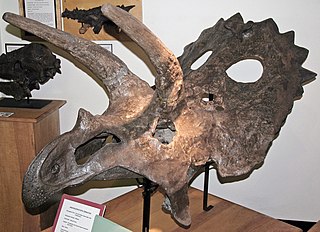
Anchiceratops is an extinct genus of chasmosaurine ceratopsid dinosaur that lived approximately 72 to 71 million years ago during the latter part of the Cretaceous Period in what is now Alberta, Canada. Anchiceratops was a medium-sized, heavily built, ground-dwelling, quadrupedal herbivore that could grow up to an estimated 4.3 metres (14 ft) long. Its skull featured two long brow horns and a short horn on the nose. The skull frill was elongated and rectangular, its edges adorned by coarse triangular projections. About a dozen skulls of the genus have been found.
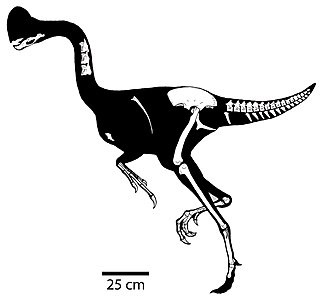
Chirostenotes is a genus of oviraptorosaurian dinosaur from the late Cretaceous of Alberta, Canada. The type species is Chirostenotes pergracilis.

Montanoceratops is an extinct genus of small ceratopsian dinosaur that lived approximately 70 million years ago during the latter part of the Cretaceous Period in what is now Montana and Alberta. Montanoceratops was a small sized, moderately-built, ground-dwelling, quadrupedal herbivore, that could grow up to an estimated 2.5 m (8.2 ft) in length and 170 kg (370 lb) in body mass.

Mononykus is a genus of alvarezsaurid dinosaur that lived during the Late Cretaceous in what is now Asia on the Nemegt Formation, about 70 million years ago.

Patagonykus is a genus of theropod dinosaur from the Upper Cretaceous of Argentina. This alvarezsauroid was discovered in exposures of the Portezuelo Formation (Turonian-Coniacian) of the Rio Neuquén Subgroup in the Neuquén Basin, Neuquen Province of Patagonia, Argentina. The holotype consists of an incomplete but well-preserved skeleton, lacking a skull, but including many vertebrae, the coracoids, a partial forelimb, pelvic girdle, and hindlimbs. Patagonykus has been classed with the Alvarezsauridae, a family which includes such taxa as the Mongolian Mononykus and the Argentinian Alvarezsaurus. In 2010 Gregory S. Paul estimated its length at 1 meter and its weight at 3.5 kg.
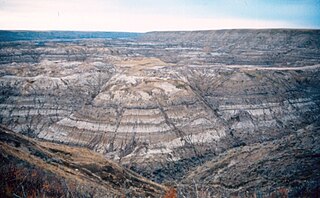
The Horseshoe Canyon Formation is a stratigraphic unit of the Western Canada Sedimentary Basin in southwestern Alberta. It takes its name from Horseshoe Canyon, an area of badlands near Drumheller.

Alvarezsauroidea is a group of small maniraptoran dinosaurs. Alvarezsauroidea, Alvarezsauridae, and Alvarezsauria are named for the historian Gregorio Álvarez, not the more familiar physicist Luis Alvarez, or his son geologist Walter Alvarez who jointly proposed that the Cretaceous–Paleogene extinction event was caused by an impact event. The group was first formally proposed by Choiniere and colleagues in 2010, to contain the family Alvarezsauridae and non-alvarezsaurid alvarezsauroids, such as Haplocheirus, which is the basalmost of the Alvarezsauroidea. The discovery of Haplocheirus extended the stratigraphic evidence for the group Alvarezsauroidea about 63 million years further in the past. The division of Alvarezsauroidea into the Alvarezsauridae and the non-alvarezsaurid alvarezsauroids is based on differences in their morphology, especially in their hand morphology.
Xixianykus is a genus of alvarezsaurid theropod dinosaur from the late Cretaceous period of China.
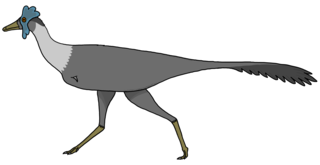
Bonapartenykus is a monospecific genus of alvarezsauroid dinosaur from Argentina that lived during the Late Cretaceous (Campanian-Maastrichtian) in what is now the upper Allen Formation of the Río Negro Province. The type and only species, Bonapartenykus ultimus, is known from a nearly articulated but partial skeleton that was found in close association to two incomplete eggs and several clusters of eggshells belonging to the oogenus Arriagadoolithus. Bonapartenykus was named in 2012 by Federico L. Agnolin, Jaime E. Powell, Fernando E. Novas and Martin Kundrát. Bonapartenykus has an estimated length of 2.5 m (8.2 ft) and weight of 72 kg (159 lb), making it the largest member of the clade Alvarezsauroidea.

Trierarchuncus is a monotypic genus of alvarezsaurid theropod which includes a single species, Trierarchuncus prairiensis, which is known from fossils found in deposits of the Hell Creek Formation in Montana. It is the youngest known alvarezsaurid and one of the last non-avian dinosaurs, going extinct during the Cretaceous–Paleogene extinction event, which occurred approximately 66 million years ago.
